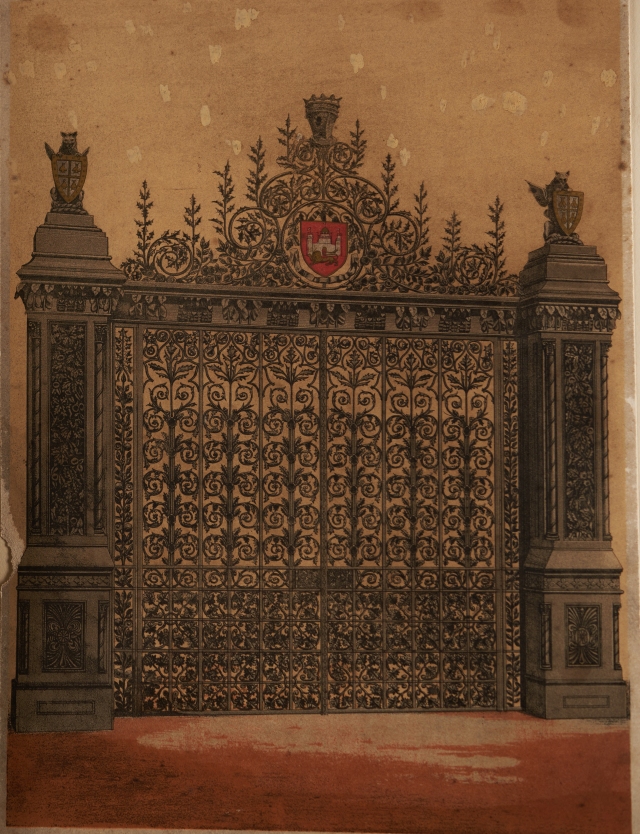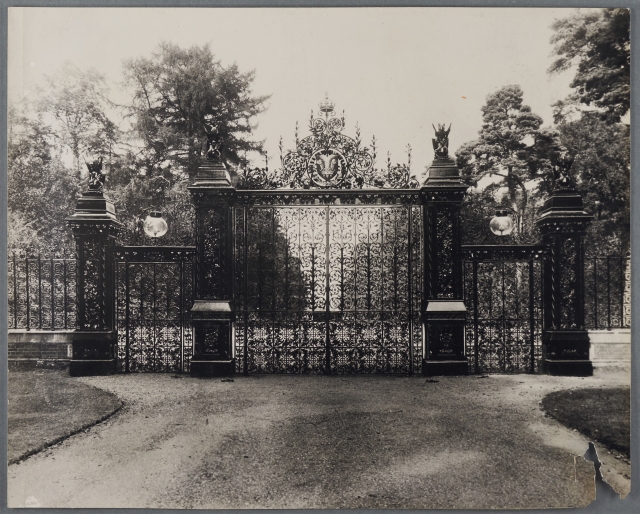The magnificent wrought-iron gates which guard the main entrance to Sandringham are called the Norwich Gates. They were made in 1862 for the International Exhibition at South Kensington, London, in the foundries of Barnard, Bishop and Barnard in Norwich, and took three years to construct. It gave Barnard, Bishop and Barnard an opportunity to show off both their craftsmanship and the design skills of Norfolk-born architect, Thomas Jeckyll.
The elaborate design of the gates incorporated roses, arums, oak leaves, acorns, vine leaves and tendrils, and the flowers and leaves of greater convolvulus. The supporting plinths were equally decorative, with panels of acanthus leaves and small quasi-Corinthian pillars in each corner. Each plinth is topped with a small dragon which holds a coat of arms. The gates are twenty-five feet high and forty feet wide.

The original design for the Norwich Gates with the Norwich coat of arms. Norfolk Record Office, BR 220/210

Detail from the Norwich Gates. NRO, BR 220/211
Under the guidance of Robert John Harvey, the Sheriff of Norfolk, a committee was established to raise money by public subscription to purchase the gates. The subscriptions, which could not exceed £5, came from people in the county of Norfolk and the city of Norwich. The gates were to be given as a wedding gift to Prince Albert Edward, the Prince of Wales, and Princess Alexandra of Denmark and it was thought that they would enhance their estate at Sandringham. Some of the decoration in the gates needed to be modified, such as the city of Norwich coat of arms and the shields held by each dragon. Additionally, the helmet was changed to a royal crown, thus reflecting the gates’ new status. They were presented to the Prince of Wales on 7 April 1863.
The gates opened onto a short drive which was flanked with ancient lime trees screening Sandringham House. However, in 1908, many of the trees were uprooted by a ferocious gale and the whole avenue was removed. The privacy previously enjoyed was lost, as the house was clearly visible from the road. It was decided that the gates should be moved to the boundary wall 160 yards further from the house and the public road was diverted. Later, King George VI, also keen to keep his family home private, installed a large raised shrubbery to disguise the house and diverted the drive further.

The Norwich Gates in their current position, seen from inside the Sandringham estate. NRO, BR 220/211
Shortly after the young Queen Elizabeth ascended to the throne, visitors to the gates, eager to join in with the general euphoria, stole some of the rosettes and tendrils from them. This was seen as an outrage and, despite warning notices and police patrols, the souvenir-hunting continued throughout her coronation year.
This blog post has been compiled from the online exhibition Royal Norfolk.














Is there a record of the list of the public subscribers who contributed to the Norwich Gates? And a list of employees of Barnard, Bishop and Barnard during the years when the gates were made?
LikeLike
Hi Caroline, thank you for your interest. The records we hold for Barnard, Bishop and Barnard can be browsed on the Norfolk Record Office catalogue using the prefix BR 220 and there are also four boxes of uncatalogued material with the catalogue reference ACC 2001/84.
I have carried out a catalogue search of our catalogued material under the ref BR 220 and it doesn’t seem that we hold a list of employees as early as 1862, although we do have a list of employees for the period 1887-1977 (ref BR 220/77-82). I have also briefly looked at two ledges we hold dating from the period the gates were built but unfortunately they do not seem to contain a list of names either.
LikeLike
My Great Great Grandfather worked atBarnard, Bishop and Barnard during the time the Norwich Gates were made and he was involved in the process in some way. He was a heraldic artist and also responsible for many illustrations in the brochures of the company. This information has been handed down through the family and, partly, in the writings of my Great Great Grandfather, but I haven’t been able to find any proof or further information anywhere. His name was William Gunn, he also taught art at Norwich School of Art. I have one of his scrapbooks which contains drawings of his work and also a photograph of The Norwich Gates at Sandringham.
LikeLike
Hello, thank you for your comment. Please free to have a look at our online catalogue for more information about the business. Here is a link to the main Barnard collection https://nrocatalogue.norfolk.gov.uk/index.php/records-of-barnards-ltd-of-salhouse-road-norwich-ironfounders and feel free to email us if you would like any further advice – norfrec@norfolk.gov.uk
LikeLike